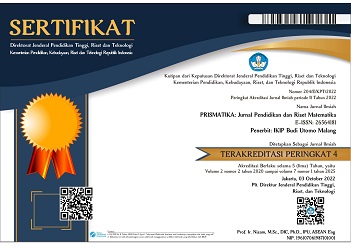PENGEMBANGAN MEDIA PEMBELAJARAN MATEMATIKA INTERAKTIF BERBASIS KETERAMPILAN ABAD 21 PADA MATERI ARITMATIKA SOSIAL
Abstract
Research on the development of interactive mathematics learning media based on 21st century skills, namely using the google sites application on social arithmetic material aims to: 1) Produce interactive mathematics learning media on Social Arithmetic concepts that are suitable for use 2) Find out how the results of developing 21st century skills-based interactive mathematics learning media in the form of a google sites application. This research is a type of development research using the ADDIE model (Analysis, Design, Development, Implementation, and Evaluation). The sample of this research is the seventh grade students of MTs Sunan Bonang Pujon, Malang. The data collection process uses an instrument in the form of a validation sheet with the aim of measuring the validity of the Google Sites Learning Media, a test to determine student learning outcomes and student responses to the Google Sites Learning Media which was developed to determine the effectiveness of Google Sites. The results of the material expert test obtained a score of 90% which showed valid criteria and the results of the media expert test obtained a score of 90% which showed valid criteria. Student test results obtained an average value of 82,5 where the value has met the minimum completeness criteria (KKM). Based on these results, it can be said that students have good mastery of Social Arithmetic material. Student response questionnaire data obtained a percentage of 89% which indicates a good category. Overall, Google Sites interactive learning media is effectively used in the learning process in order to increase students' understanding of Social Arithmetic material and can motivate students in the learning process.
References
Arda, S. S., & Darsikin. (2015). Pengembangan Media Pembelajaran Interaktif Berbasis Komputer untuk Siswa SMP Kelas VIII. Jurnal Mitra Sains, 3(1), 69-77.
Arief, R. (2017). Aplikasi Presensi Siswa Online Menggunakan Google Form, Sheets, Sites, Awesome, Table, dan Gmail. Seminar Nasional Sains Dan Teknologi Terapan V, 137-144.
BSNP. (2010). Paradigma Pendidikan Nasional Abad XXI. Jakarta.
Dale, E. (1969). Audiovisual methods in teaching. 3rd ed., 1969, Holt, Rinehart and Winston.
Fakhruddin, M. A., & Istiningsih, S. (2013). Perubahan Paradigma Dalam Organisasi Belajar Di Abad 21. Perspektif Ilmu Pendidikan, 27 (2), 110-
117.
Frydenberg, M., & Andone, D. (2011). Learning for 21 st Century Skills. 314- 318.
Habibi, B. (2017). Pengembangan media pembelajaran interaktif multimedia menggunakan Kvisoft Flipbook maker berbasis Etnomatematika. UIN Raden Intan Lampung.
Harsanto, B. (2014). Inovasi Pembelajaran di Era Digital: Menggunakan Google Sites dan Media Sosial (S. Sonjaya (ed);1st ed.). UNPAD PRESS.
Hiedayat, S. W. (2010). Pengembangan Komputer Pembelajaran (CAI) Tentang Gerak Lurus Berubah Beraturan Pada Mata Pelajaran Fisika Bagi Siswa Kelas VII SMP Negeri 2 Surabaya. Jurnal Mahasiswa Teknologi Pendidikan 1, 1-106.
Ima Nurjayanti, A. (2015). Pengembangan Multimedia Pembelajaran Matematika Berbasis Android Untuk Siswa Kelas 3 Sekolah Dasar.
Islam, M. S., & Fahmi, S. (2019). Pengembangan Media Pembelajaran Interaktif Matematika Menggunakan Macromedia Flash 8 Pada Materi Aritmatika Sosial untuk Siswa SMP Kelas VII Semester Genap. Seminar Nasional Pendidikan Matematika Ahmad Dalan 6.
Istiqlal, M. (2017). Pengembangan multimedia interaktif dalam pembelajaran matematika. JIPMat, 2(1).
Kemendikbud, L. (2013). Kurikulum 2013: Pergerseran Paradigma Belajar Abad-21.Retrieved from http://litbang.kemdikbud.go.id/index.php/index-berita-kurikulum/243-kurikulum-2013-pergeseran-paradigma-belajar-
abad-21.
Masters, K. (2013). Edgar Dale`s Pyramid of Learning in medical education: A literature review. Media Teacher, 35(11), 1584-1593.
Mulyatiningsih, E. (2014). Metode Penelitian Terapan Bidang Pendidikan. Bandung: Alfabeta.
Munadi, Y. (2008). Media Pembelajaran, Sebuah Pendekatan Baru. Jakarta: Gaung Persada Press.
NCTM. (n.d.). Principles and standards for school mathematics. Reston: The National Council of Teachers os Mathematics, Inc.
Purnamasari, S., & Herman, T. (2016). Penggunaan Multimedia Interaktif Terhadap Peningkatan Kemampuan Pemahaman dan Komunikasi Matematis, Serta Kemandirian Belajar Siswa Sekolah Dasar. EduHumaniora JURNAL PENDIDIKAN DASAR, 8, 178-185.
Rachmadyanti, P., & Gunansyah, G. (2020). Pengembangan Ebook untuk Mata Kuliah Konsep Dasar IPS Lanjut bagi Mahasiswa PGSD UNESA. Jurnal Riset Pedagogik, 4(1), 83-93.
Rachmantika, A. R., & Wardono, W. (2019, February). Peran Kemampuan Berpikir Kritis Siswa pada Pembelajaran Matematika dengan Pemecahan Masalah. In PRISMA, Prosiding Seminar Nasional Matematika , (Vol.2, pp. 439-443).
rief, R. (2017). Aplikasi Presensi Siswa Online Menggunakan Google Form, Sheets, Sites, Awesome, Table dan Gmail. Seminar Nasional Sains Dan Teknologi Terapan V , 137-144.
Sanaky, H. (2013). Media Pembelajaran Interaktif-Inovatif. Kaukaba Dipantara.
Siamy, L., Farida, F., & Syazali, M. (2018). Media Belajar Matematika Berbasis Multimedia Interaktif dengan Pendekatan Contextual Teaching and Learning. Desimal: Jurnal Matematika, 1(1), 113-117.
Sudirman. (2012). Pengembangan Media Pembelajaran. Pedagogia.
Trilling, B., & Fadel, C. (2009). 21st Century Skills: Learning for Life in Our Times. San Fransisco: Calif., Jossey-Bass/John Wiley & Sons, Ins.
Waskito, D. (2014). Media Pembelajaran Interaktif Matematika Bagi Sekolah Dasar Kelas 6 Berbasis Multimedia. Speed Jurnal-Sentra Penelitian Engineering Dan Edukasi, 11(3), 59-65.
Wibowo, E. J. (2013). Media pembelajaran interaktif matematika untuk siswa sekolah dasar kelas IV. Seruni-Seminar Riset Unggulan Nasional Informatika Dan Komputer, 2(1).







.png)




